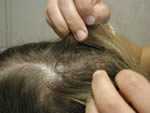Diagnosis

Examination of hair and scalp for head lice. Close examination of the hair and scalp is necessary to determine head lice infestation. (CDC Photo)
Misdiagnosis of head lice infestation is common. The diagnosis of head lice infestation is best made by finding a live nymph or adult louse on the scalp or hair of a person.
Because adult and nymph lice are very small, move quickly, and avoid light, they may be difficult to find. Use of a fine-toothed louse comb may facilitate identification of live lice.
If crawling lice are not seen, finding nits attached firmly within ¼ inch of the base of hair shafts suggests, but does not confirm, the person is infested. Nits frequently are seen on hair behind the ears and near the back of the neck. Nits that are attached more than ¼ inch from the base of the hair shaft are almost always non-viable (hatched or dead). Head lice and nits can be visible with the naked eye, although use of a magnifying lens may be necessary to find crawling lice or to identify a developing nymph inside a viable nit. Nits are often confused with other particles found in hair such as dandruff, hair spray droplets, and dirt particles.
If no nymphs or adults are seen, and the only nits found are more than ¼ inch from the scalp, then the infestation is probably old and no longer active — and does not need to be treated.
- Page last reviewed: September 24, 2013
- Page last updated: September 24, 2013
- Content source:


 ShareCompartir
ShareCompartir